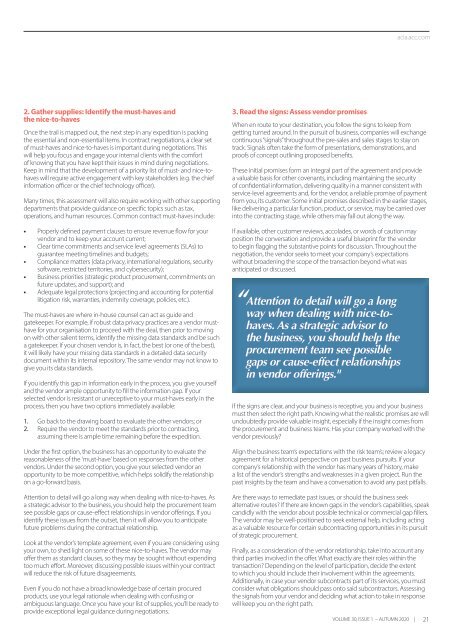Australian Corporate Lawyer - Autumn 2020
Australian Corporate Lawyer is the official publication of the Association of Corporate Counsel (ACC) Australia. The Autumn 2020 issue focuses on contract negotiation and features a range of articles covering topics including the importance of EQ for lawyers; managing employment rights in the social media age and addressing conflict in the workplace.
Australian Corporate Lawyer is the official publication of the Association of Corporate Counsel (ACC) Australia. The Autumn 2020 issue focuses on contract negotiation and features a range of articles covering topics including the importance of EQ for lawyers; managing employment rights in the social media age and addressing conflict in the workplace.
Create successful ePaper yourself
Turn your PDF publications into a flip-book with our unique Google optimized e-Paper software.
acla.acc.com<br />
2. Gather supplies: Identify the must-haves and<br />
the nice-to-haves<br />
Once the trail is mapped out, the next step in any expedition is packing<br />
the essential and non-essential items. In contract negotiations, a clear set<br />
of must-haves and nice-to-haves is important during negotiations. This<br />
will help you focus and engage your internal clients with the comfort<br />
of knowing that you have kept their issues in mind during negotiations.<br />
Keep in mind that the development of a priority list of must- and nice-tohaves<br />
will require active engagement with key stakeholders (e.g. the chief<br />
information officer or the chief technology officer).<br />
Many times, this assessment will also require working with other supporting<br />
departments that provide guidance on specific topics such as tax,<br />
operations, and human resources. Common contract must-haves include:<br />
••<br />
Properly defined payment clauses to ensure revenue flow for your<br />
vendor and to keep your account current;<br />
••<br />
Clear time commitments and service level agreements (SLAs) to<br />
guarantee meeting timelines and budgets;<br />
••<br />
Compliance matters (data privacy, international regulations, security<br />
software, restricted territories, and cybersecurity);<br />
••<br />
Business priorities (strategic product procurement, commitments on<br />
future updates, and support); and<br />
••<br />
Adequate legal protections (projecting and accounting for potential<br />
litigation risk, warranties, indemnity coverage, policies, etc.).<br />
The must-haves are where in-house counsel can act as guide and<br />
gatekeeper. For example, if robust data privacy practices are a vendor musthave<br />
for your organisation to proceed with the deal, then prior to moving<br />
on with other salient terms, identify the missing data standards and be such<br />
a gatekeeper. If your chosen vendor is, in fact, the best (or one of the best),<br />
it will likely have your missing data standards in a detailed data security<br />
document within its internal repository. The same vendor may not know to<br />
give you its data standards.<br />
If you identify this gap in information early in the process, you give yourself<br />
and the vendor ample opportunity to fill the information gap. If your<br />
selected vendor is resistant or unreceptive to your must-haves early in the<br />
process, then you have two options immediately available:<br />
1. Go back to the drawing board to evaluate the other vendors; or<br />
2. Require the vendor to meet the standards prior to contracting,<br />
assuming there is ample time remaining before the expedition.<br />
Under the first option, the business has an opportunity to evaluate the<br />
reasonableness of the 'must-have' based on responses from the other<br />
vendors. Under the second option, you give your selected vendor an<br />
opportunity to be more competitive, which helps solidify the relationship<br />
on a go-forward basis.<br />
Attention to detail will go a long way when dealing with nice-to-haves. As<br />
a strategic advisor to the business, you should help the procurement team<br />
see possible gaps or cause-effect relationships in vendor offerings. If you<br />
identify these issues from the outset, then it will allow you to anticipate<br />
future problems during the contractual relationship.<br />
Look at the vendor’s template agreement, even if you are considering using<br />
your own, to shed light on some of these nice-to-haves. The vendor may<br />
offer them as standard clauses, so they may be sought without expending<br />
too much effort. Moreover, discussing possible issues within your contract<br />
will reduce the risk of future disagreements.<br />
Even if you do not have a broad knowledge base of certain procured<br />
products, use your legal rationale when dealing with confusing or<br />
ambiguous language. Once you have your list of supplies, you’ll be ready to<br />
provide exceptional legal guidance during negotiations.<br />
3. Read the signs: Assess vendor promises<br />
When en route to your destination, you follow the signs to keep from<br />
getting turned around. In the pursuit of business, companies will exchange<br />
continuous “signals” throughout the pre-sales and sales stages to stay on<br />
track. Signals often take the form of presentations, demonstrations, and<br />
proofs of concept outlining proposed benefits.<br />
These initial promises form an integral part of the agreement and provide<br />
a valuable basis for other covenants, including maintaining the security<br />
of confidential information, delivering quality in a manner consistent with<br />
service-level agreements and, for the vendor, a reliable promise of payment<br />
from you, its customer. Some initial promises described in the earlier stages,<br />
like delivering a particular function, product, or service, may be carried over<br />
into the contracting stage, while others may fall out along the way.<br />
If available, other customer reviews, accolades, or words of caution may<br />
position the conversation and provide a useful blueprint for the vendor<br />
to begin flagging the substantive points for discussion. Throughout the<br />
negotiation, the vendor seeks to meet your company’s expectations<br />
without broadening the scope of the transaction beyond what was<br />
anticipated or discussed.<br />
“<br />
Attention to detail will go a long<br />
way when dealing with nice-tohaves.<br />
As a strategic advisor to<br />
the business, you should help the<br />
procurement team see possible<br />
gaps or cause-effect relationships<br />
in vendor offerings."<br />
If the signs are clear, and your business is receptive, you and your business<br />
must then select the right path. Knowing what the realistic promises are will<br />
undoubtedly provide valuable insight, especially if the insight comes from<br />
the procurement and business teams. Has your company worked with the<br />
vendor previously?<br />
Align the business team’s expectations with the risk team’s; review a legacy<br />
agreement for a historical perspective on past business pursuits. If your<br />
company’s relationship with the vendor has many years of history, make<br />
a list of the vendor’s strengths and weaknesses in a given project. Run the<br />
past insights by the team and have a conversation to avoid any past pitfalls.<br />
Are there ways to remediate past issues, or should the business seek<br />
alternative routes? If there are known gaps in the vendor’s capabilities, speak<br />
candidly with the vendor about possible technical or commercial gap fillers.<br />
The vendor may be well-positioned to seek external help, including acting<br />
as a valuable resource for certain subcontracting opportunities in its pursuit<br />
of strategic procurement.<br />
Finally, as a consideration of the vendor relationship, take into account any<br />
third parties involved in the offer. What exactly are their roles within the<br />
transaction? Depending on the level of participation, decide the extent<br />
to which you should include their involvement within the agreements.<br />
Additionally, in case your vendor subcontracts part of its services, you must<br />
consider what obligations should pass onto said subcontractors. Assessing<br />
the signals from your vendor and deciding what action to take in response<br />
will keep you on the right path.<br />
VOLUME 30, ISSUE 1 – AUTUMN <strong>2020</strong> | 21
















